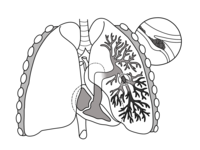
Photo from wikipedia
OBJECTIVE To identify prognostic factors associated with 90-day mortality in patients with oesophageal perforation (OP), and characterize the specific timeline from presentation to intervention, and its relation to mortality. BACKGROUND… Click to show full abstract
OBJECTIVE To identify prognostic factors associated with 90-day mortality in patients with oesophageal perforation (OP), and characterize the specific timeline from presentation to intervention, and its relation to mortality. BACKGROUND OP is a rare gastro-intestinal surgical emergency with a high mortality rate. However, there is no updated evidence on its outcomes in the context of centralized esophago-gastric services; updated consensus guidelines; and novel non-surgical treatment strategies. METHODS A multi-center, prospective cohort study involving eight high-volume esophago-gastric centers (January 2016 to December 2020) was undertaken. The primary outcome measure was 90-day mortality. Secondary measures included length of hospital and ICU stay, and complications requiring re-intervention or re-admission. Mortality model training was performed using random forest, support-vector machines, and logistic regression with and without elastic net regularisation. Chronological analysis was performed by examining each patient's journey timepoint with reference to symptom onset. RESULTS The mortality rate for 369 patients included was 18.9%. Patients treated conservatively, endoscopically, surgically, or combined approaches had mortality rates of 24.1%, 23.7%, 8.7%, and 18.2%, respectively. The predictive variables for mortality were Charlson comorbidity index, haemoglobin count, leucocyte count, creatinine levels, cause of perforation, presence of cancer, hospital transfer, CT findings, whether a contrast swallow was performed, and intervention type. Stepwise interval model showed that time to diagnosis was the most significant contributor to mortality. CONCLUSION Non-surgical strategies have better outcomes and may be preferred in selected cohorts to manage perforations. Outcomes can be significantly improved through better risk-stratification based on afore-mentioned modifiable risk factors.
Journal Title: Annals of surgery
Year Published: 2023
Link to full text (if available)
Share on Social Media: Sign Up to like & get
recommendations!